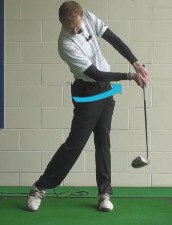
Hip Turn in Golf
Golf is a sport that requires a combination of skill, technique, and physical fitness. One important aspect of a golfer's technique is the hip turn. The hip turn is a fundamental movement that plays a crucial role in generating power and maintaining balance throughout the swing. Understanding how to execute a proper hip turn can greatly improve your golf game. Let's delve into the details of this golf term.
- Definition
- Importance
- Execution
- Address the ball with a shoulder-width stance and proper posture.
- On the backswing, initiate the hip turn by rotating your lead hip (left hip for right-handed golfers) away from the target. Keep your weight balanced and allow the rotation to be smooth and controlled.
- At the top of the backswing, your hips should have turned to approximately 45 degrees. Avoid excessive tilting or swaying.
- As you transition into the downswing, start the hip turn towards the target by rotating your trail hip (right hip for right-handed golfers) towards the target.
- Keep your lower body stable while the upper body rotates. This separation of movement between the upper and lower body is known as the hip and shoulder separation.
- Through impact and into the follow-through, continue the rotation of your hips until they face the target.
- Common Mistakes
- Over-rotating the hips on the backswing: This can lead to an overly long backswing and a loss of balance.
- Not initiating the hip turn on the downswing: This results in a lack of power and a swing dominated by the upper body.
- Not maintaining stability in the lower body: Allowing the lower body to sway or slide can cause inconsistencies in the swing.
- Practice Drills
- Slow-motion swings: Practice your swing in slow motion, focusing on the rotation of your hips throughout the entire motion.
- Chair drill: Take a chair and place it behind you. During your backswing, lightly touch the chair with your backside, mimicking the hip rotation.
- Resistance band drill: Attach a resistance band around your hips and practice your swing. The resistance will help you feel the correct hip movement.
- Conclusion
The hip turn in golf refers to the rotational movement of the hips during the golf swing. It involves the rotation of the hips away from the target on the backswing and then towards the target on the downswing.
The hip turn is critical because it helps create torque, which is the angular force that generates clubhead speed and distance. Without a proper hip turn, a golfer may struggle to generate power and may compensate by using other less efficient parts of the body, leading to inconsistent shots and potential injury.
To execute a proper hip turn, follow these key steps:
Here are some common mistakes golfers make with their hip turn:
Improving your hip turn requires practice. Here are a few drills to help you:
The hip turn is an essential component of a golfer's swing. By mastering the proper execution of the hip turn, you can add more power and consistency to your shots. Remember, practice and repetition are key to improving your golf game, so take the time to work on your hip turn regularly.





